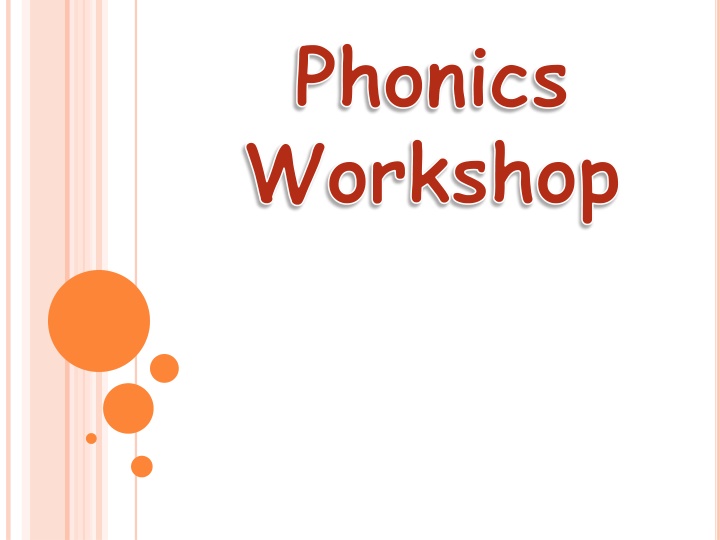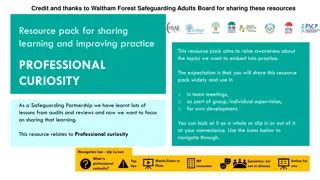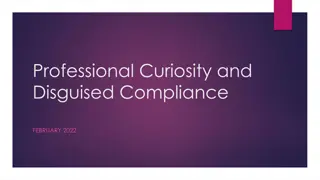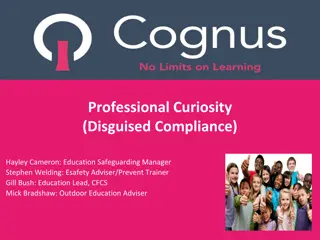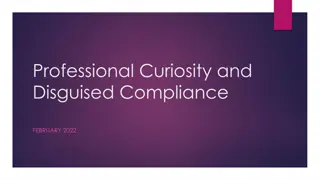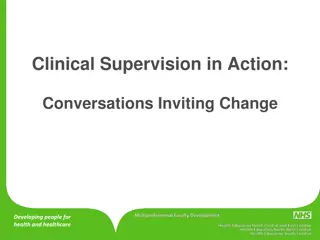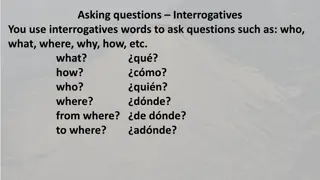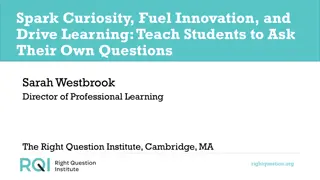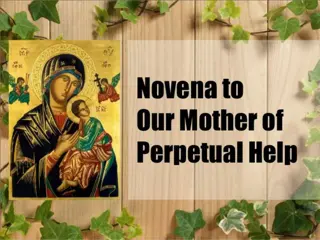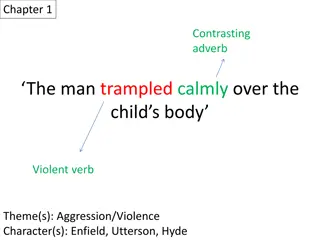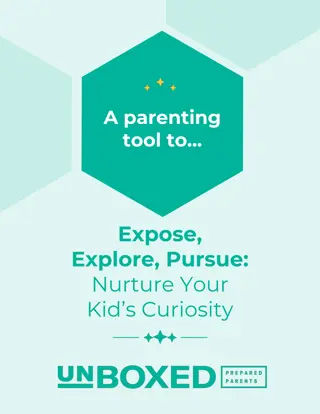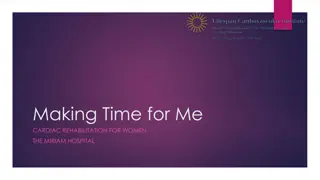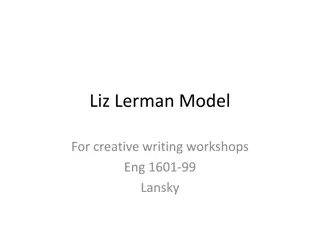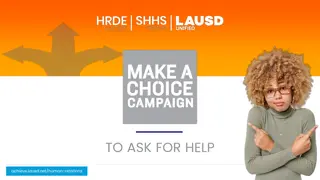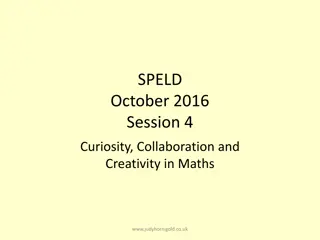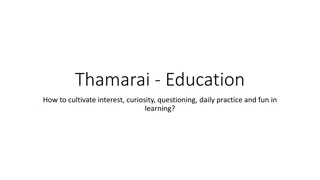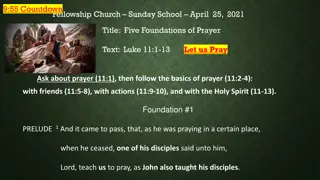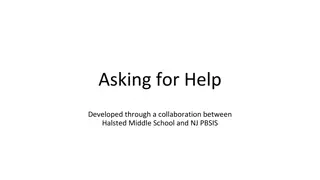Learn by Asking: Embracing Curiosity and Seeking Help
Embrace the power of questions to enhance learning. Ask questions to gain new knowledge, seek help when uncertain, and clarify understanding. Learn the importance of thinking before asking, reaching out to friends, and consulting teachers. Patience is key when waiting for your turn to ask. Follow three simple steps: self-assessment, reaching out to peers, and seeking guidance from adults. Foster a curious mindset and be open to seeking answers through inquiry.
Download Presentation

Please find below an Image/Link to download the presentation.
The content on the website is provided AS IS for your information and personal use only. It may not be sold, licensed, or shared on other websites without obtaining consent from the author.If you encounter any issues during the download, it is possible that the publisher has removed the file from their server.
You are allowed to download the files provided on this website for personal or commercial use, subject to the condition that they are used lawfully. All files are the property of their respective owners.
The content on the website is provided AS IS for your information and personal use only. It may not be sold, licensed, or shared on other websites without obtaining consent from the author.
E N D
Presentation Transcript
Phonics Workshop
In school, we follow the Letters and Sounds programme. Letters and Sounds is a phonics resource published by the Department for Education and Skills which consists of six phases.
oPhonics for reading First children are taught to read letters, or groups of letters by saying the letter sounds. Children can then start to read words by blending the sounds together to make a word. oPhonics for writing Children are taught to reverse this process saying the word and then segmenting the sounds.
The Phonic Alphabet The English language has 44 phonemes ~ (a phoneme is the smallest unit of sound in a word.) Children are taught to write each letter forming it accurately. Phonemes should be articulated clearly and precisely.
Children are taught to produce the shortest sounds possible e.g. no uh on the end of d and g . https://www.youtube.com/watch? v=vMEvxTGvi4c
How do we teach Phonics at Hanslope? We use Letters and Sounds. This is split into 6 phases. Children are taught according to ability. Phase 1 takes place at Nursery/ Pre-school. In this phase children s speaking and listening skills are fostered.
PHASE 1 There are 7 aspects. A1 Environmental A2 Instrumental sounds A3 Body percussion A4 Rhythm and rhyme A5 Alliteration e.g. juicy jelly , sizzling sausages A6 Voice sounds A7 Oral blending and segmenting.
PHASE 2 This phase is taught in the Reception class (Maple/Holly). Children are taught 19 phonemes and graphemes. By the end of Phase 2 many children should be able to read some Vowel Consonant (VC) words e.g. at, in and some Consonant Vowel Consonant (CVC) words e.g. sat, pin Some children will also be able to spell the words as well.
Phase 2 is taught through Jolly Phonics where a story, action and song are taught.
PHASE 2 Set 1: s, a, t, p Set 2: i, n, m, d Set 3: g, o, c, k Set 4: ck, e, u, r Set 5: h, b, f, ff, l, ll, ss
Children are also taught some tricky words. These are words that can not be segmented and blended. They just have to be learnt! the, to, I, no, go, into
PHASE3 This phase is also taught in the Reception class (Maple/Holly). Children are taught the next 25 phonemes and graphemes. Most of these letters are digraphs two letters one sound. e.g. oa as in boat, coat (a vowel digraph) and sh as in ship, shop (a consonant digraph). More tricky words are learnt as well, he, she, we, me, be, was, you, they, all, are, my, her.
PHASE 3 Set 6: j, v, w, x Set 7: y, z, zz, qu Consonant digraphs: ch, sh, th, ng Vowel digraphs: ai, ee, oa, oo, ar, or, ur, ow, oi, er Trigraphs: igh, ear, air, ure.
PHASE 4 RECEPTION/YEAR 1 This phase consolidates all the children have learnt in the previous phases. Children learn to blend and read words containing adjacent consonants e.g. stop, twin, grab. More tricky words are learnt as well; said, have, like, so, do, some, come, were, there, little, one, when, out, what.
PHASE 5 YEAR 1/2 Children will be taught new graphemes. Vowel digraphs: wh, ph, ay, ou, ie, ea, oy, ir, ue, aw, ew, oe, au. Split digraphs: a_e, e_e, i_e, o_e, u_e.
Children will be also be taught alternative pronunciations for these graphemes. E.g. ai ~ ay as in day, a-e as in make, ee ~ ea as in sea, e-e as in theme, y as in happy, ie as in field, ey as in money. igh ~ ie as in pie, y as in my, i-e as in time. oa ~ ow as in snow, oe as in toe, o-e as in bone. Long oo ~ ue as in cue, ew as in new, u-e as in cube. Short oo ~ ue as in clue, u-e as in flute, ew as in blew.
When spelling words children learn to choose the appropriate graphemes to represent phonemes. More tricky words are learnt; oh, their, people, Mr, Mrs, looked, called, asked, could.
PHASE 6 YEAR 2 By this phase children should be able to read hundreds of words by; o Reading the words automatically o Decoding them quickly and silently because their sounding and blending routine is now well established o Decoding aloud o Spelling should be phonetically accurate although it may still be a little unconventional at times!
The focus in phase 6 is on learning spelling rules for the suffixes -s -er -ful -ly -es -est -ing -ed -y -en -ment -ness e.g. drop the e before adding an ing like/liking
Reading Sharing wordless books is a terrific way to build important literacy skills. Children are learning how books work, using cues from the pictures to tell a story, developing their vocabulary, comprehension and an increased awareness of how stories are built telling stories with a beginning, middle and end. As we begin our phonic journey, learning that letters represent sounds, children can begin to decode simple texts and hopefully begin to develop a love of books and a desire to read.
Sharing a Book Always talk about the title, the pictures and the information on the front and back cover and ask what your child thinks the book might be about. Look through the book and play letter- spotting and word games like can you find the word and on this page? How many words can you find that begin with t ? Ask questions about what has been read.
SEGMENTINGAND BLENDING If your child gets stuck on a word encourage them to segment it by saying the letter sounds individually and then putting them together quickly to hear the word. c a t cat
SEGMENTINGAND BLENDING Qu ee n queen
Remember some words are Tricky Words. Words that can not be segmented and blended. They just have to be learnt! E.g the, to, I, no, go, into
SEGMENTING cat c a t Breaking down words for spelling.
SEGMENTING Queen qu ee n
WHATDOESA PHONICSLESSON LOOKLIKE? Revisit/review Flashcards to practice phonemes learnt so far. Teach Practice Teach new phoneme e.g. Air. Buried treasure Air, zair, fair, hair, lair, pair, vair, sair, thair. Read captions: The goat had a long beard. The quack was right in his ear. Apply
NATIONAL PHONICS SCREENING CHECK Children will take part in a national phonics screening check. The phonics screening check is designed to confirm whether pupils have learnt phonic decoding to an appropriate standard. It will identify pupils who need extra help to improve their decoding skills. The check consists of 20 real words and 20 pseudo-words that a pupil reads aloud to the teacher.
HOWTOHELPATHOME o Practise sounds: sign posts, car registration plates etc. o Challenge children to find objects that begin with a certain sound. o Play I spy with phonemes not letter names. o Practise letter formation o Play rhyming games o Word cards will be sent home, play games with them. o Make sentences with the word cards. o Make it FUN!
RESOURCES On the school website we have a list of Phonics Websites and Apps that can be used to support the teaching of phonics at home.
Terminology On the school website is a document which explains the terminology that is used when teaching phonics. If you have any queries about the teaching of phonics please contact us on lisa.lawrence@hanslope.milton-keynes.sch.uk jane.fox@hanslope.milton-keynes.sch.uk Thank you!
